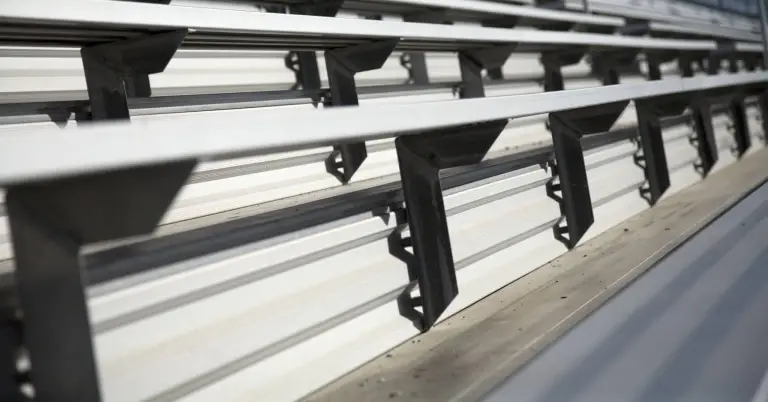
As environmental concerns become increasingly paramount today, the need for sustainable practices in all aspects of life has never been more pressing. One often-overlooked area where sustainability can significantly impact is the realm of seating for large gatherings, such as in sports arenas, schools, and community centers. Opting for used bleachers instead of new ones can be a remarkably eco-friendly. This article will explore why used bleachers are a sustainable option, the environmental benefits of reusing and recycling seating, and practical tips for purchasing and maintaining used bleachers.
The Environmental Impact of New Bleachers
To understand the environmental benefits of used bleachers, it's essential to consider the impact of producing new ones. Manufacturing bleachers involves several resource-intensive processes:
Resource Extraction and Processing
New bleachers are typically made from steel, aluminum, and plastic materials. The extraction of these raw materials requires mining and refining, which consume significant amounts of energy and water while generating considerable waste and pollution. For example, aluminum production is energy-intensive and creates large quantities of greenhouse gases.
Manufacturing and Transportation
Once raw materials are processed, they must be transported to manufacturing facilities, often far from mining sites, adding to the carbon footprint. Fabricating bleachers involves additional energy consumption and emissions. Finally, transporting finished bleachers to their final destination contributes further to their environmental impact, especially if they are shipped long distances.
Disposal and Waste
When bleachers reach the end of their useful life, disposal poses another environmental challenge. Many components are not biodegradable and can persist in landfills for centuries. Improper disposal can lead to soil and water pollution.
The Advantages of Choosing Used Bleachers
By opting for used bleachers, organizations can significantly mitigate these environmental impacts. Here are some compelling reasons why used bleachers are an eco-friendly choice:
Reduced Resource Consumption
Purchasing used bleachers eliminates the need for new raw materials. This reduction in demand decreases the environmental strain associated with mining, refining, and manufacturing. By extending the lifecycle of existing bleachers, we make better use of the resources already expended in their initial production.
Lower Carbon Footprint
The carbon footprint of used bleachers is substantially lower than that of new ones. Since the production phase has already occurred, the primary environmental impact comes from transportation and any refurbishment required. Even with these considerations, the overall emissions are far less than those of producing new bleachers from scratch.
Waste Minimization
Reusing bleachers helps keep large, bulky items out of landfills. This waste diversion reduces the burden on waste management systems and decreases the pollution associated with landfill sites. By choosing grandstands for sale, organizations contribute to a circular economy, where products are reused, repaired, and recycled rather than discarded.
Cost-Effectiveness
Beyond environmental benefits, used bleachers are often more cost-effective. They typically come at a fraction of the price of new ones, allowing organizations to allocate resources to other sustainability initiatives or improvements. This cost-saving aspect makes eco-friendly choices accessible to schools, community centers, and smaller sports clubs.
Practical Considerations for Purchasing Used Bleachers
While the benefits of used bleachers are clear, it's essential to approach the purchasing process thoughtfully to ensure safety, functionality, and longevity. Here are some key considerations:
Assessing Condition and Safety
Before purchasing used bleachers:
- Conduct a thorough inspection to assess their condition.
- Look for signs of wear and tear, structural integrity, and any necessary repairs.
- Ensure that all safety features, such as guardrails and non-slip surfaces, are intact and meet current safety standards.
Sourcing Reliable Suppliers
Finding a reputable supplier is crucial. Look for companies specializing in refurbished or second-hand bleachers with a track record of providing quality products. Check reviews, ask for references, and verify that the supplier adheres to industry safety standards.
Customization and Upgrades
Used bleachers can often be customized or upgraded to meet specific needs. For instance, you may want to add seating, improve accessibility features, or incorporate branding. Discuss these options with your supplier to ensure the bleachers can be modified to fit your requirements.
Transportation and Installation
Consider the logistics of transporting and installing used bleachers. Professional installation is recommended to ensure safety and compliance with local regulations. Some suppliers offer installation services, which can be convenient and cost-effective.
Regular Maintenance
Once installed, regular maintenance is essential to prolong the lifespan of your bleachers. Establish a maintenance schedule that includes routine inspections, cleaning, and prompt repairs of any damage. This proactive approach will help maintain safety and functionality over time.
Case Studies: Successful Implementation of Used Bleachers
Several organizations have successfully implemented used bleachers, reaping both environmental and financial benefits. Here are a few examples:
School Districts
Many school districts across the United States have used bleachers to upgrade their sports facilities. By choosing refurbished bleachers, these schools have saved money while promoting sustainability. The saved funds are often redirected to educational programs, benefiting the community.
Community Sports Clubs
Community sports clubs frequently operate on tight budgets. Used bleachers used for sale provide an affordable solution for seating needs, allowing these clubs to enhance their facilities without financial strain. Additionally, the reduced environmental impact aligns with the values of many community-based organizations.
Municipal Stadiums
Some municipalities have embraced the eco-friendly benefits of used bleachers for public sports venues and event spaces. These projects often receive positive feedback from the community for their sustainability efforts, enhancing the municipality's reputation and fostering a sense of civic pride.
Conclusion
In a world where sustainability is increasingly vital, choosing used bleachers represents a significant step towards more eco-friendly practices. The environmental benefits, including reduced resource consumption, lower carbon footprints, and minimized waste, make them an excellent choice for schools, community centers, and sports clubs. Additionally, the cost savings associated with used bleachers allow organizations to invest in other important initiatives.
By carefully selecting and maintaining used bleachers, organizations can provide safe and functional seating while contributing to a more sustainable future. As we continue to seek ways to reduce our environmental impact, reusing and recycling products like bleachers can make a meaningful difference.




